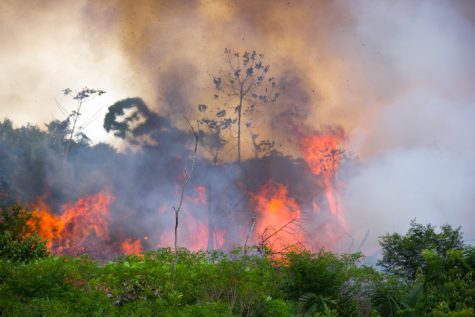Fires continue to negatively impact the Amazon rainforest
September 12, 2019

The Amazon rainforest is the world’s largest tropical rainforest and the Earth’s most biodiverse region, bigger than the next two largest rainforests combined. The climate is extremely tropical and is mainly composed of hot, humid and wet conditions. It has existed for over 50 million years and produces over 20% of the world’s oxygen, and it is also responsible for many medicines that we use today because of the medicinal plants that grow there.
This ecosystem also plays a crucial role in helping to stabilize the Earth’s climate. It covers over 5.5 million square kilometers and is home to an extensive variety of birds, animals, fish, plants and more. The Amazon fires that have been consistent for weeks now are making a negative impact on our climate as well as all creatures that live there.
Recently, there have been a vast amount of news updates talking about the rainforest and the fires that have continued to burn miles of the forest. The fires started in Brazil and are spreading into Bolivia, Peru and Paraguay. These fires are believed to be set purposely to clear land for farming and logging, yet they are being made increasingly worse due to the dry season the Amazon is currently experiencing.
This year, the number of fires that have happened is at the highest number we have seen since 2010, with more than 90,000 active fires and counting. These fires can be visible from space and have been consistently clearing miles of the rainforest in Brazil every single day. At least 2.5 million acres have burned already, and there are no signs of the fires stopping.
Besides destroying all the nature and habitats, the fires are also impacting the climate negatively. The Amazon absorbs 2 billion tons of carbon dioxide every year, so the areas that are on fire are not only helping to absorb the carbon dioxide, they are adding carbon to the air from the burning. After being set on fire, the forest takes around 20 to 40 years to “regenerate”, and it’s not even a given that it will. Experts are concerned about permanent damage and don’t necessarily know what the result will be once the flames die down.
Experts say that the Amazon is home to 10% of earth’s creatures. A new species is discovered at least every two days. These animals are unique and dangerous, and there are some species that exist that we haven’t even discovered yet.
On the other hand, there are also hundreds of endangered and threatened species that reside in the Amazon rainforest. These species are being further threatened by the fires that continue to happen, as well as other destructive man-made actions, such as logging and cattle ranching. The animals that live in the areas that have gone up in flames most likely died from the heat or smoke inhalation, and the animals that survived are left without a home and in way worse climate conditions.
There are probably minimal casualties for animals living in big bodies of water, but the fires have been burning over small bodies of water, leading to severe casualties for whatever plants or animals reside there. The fires are having long term effects on the ecosystem, which could be problematic for many species who rely on the current ecosystem conditions.
While these fires continue to happen, there are small ways that we can attempt to maintain a better climate and ecosystem for all living creatures. The Rainforest Action Network gives the option of protecting an acre of land, and similarly the Rainforest Trust organization gives the option of purchasing land for yourself.
Another way to help out is by simply supporting the indigenous populations, and there are many ways to do so. Many people don’t realize that there are still many groups of people that live nearby and are being negatively affected by the fires the same way that the animals are being affected. If you don’t want to become involved in any organizations, simply reducing your wood and paper consumption and eating ethically are also small ways to make a difference. We can only hope that these fires die down soon and that there aren’t many lasting effects due to them.











